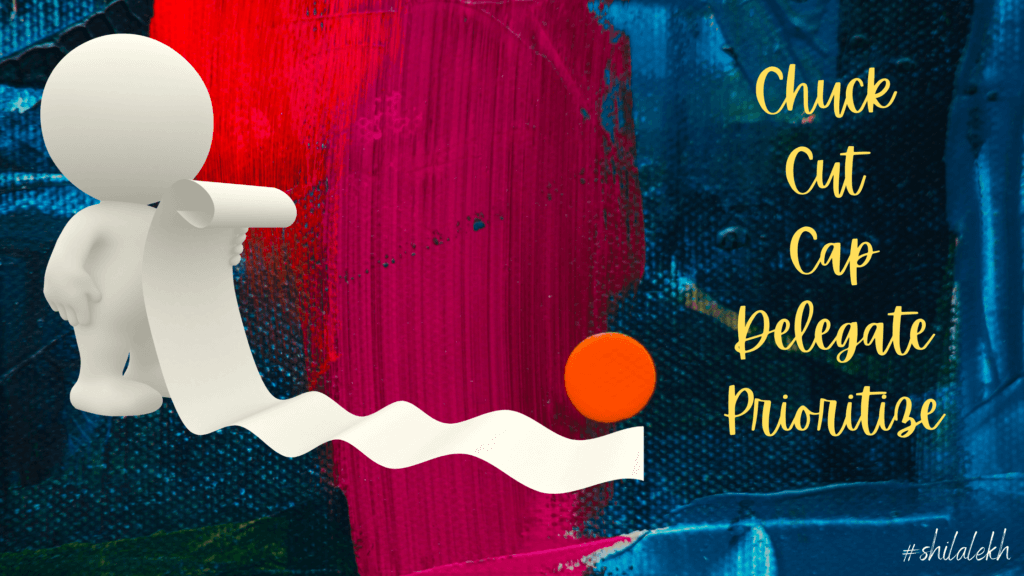
As I have repeated often in the past, you need to have a superlist rather than a to do list to supercharge your day. Superlist is a list of all your professional and personal commitments. So how is a superlist different to a to-do list?
Superlist is a list of tasks that must be finished. To do
list is a list of tasks that must be done by you.
Did you notice the subtle difference?
The moment you say to do list, you yourself get the
impression that these are all tasks that have to be done by you personally.
But you had just jotted down everything that needs to be done. When did it
convert into a list of jobs that must be done by you personally?
That’s the beauty of words – simply using the correct words or terms makes such a difference.
As mentioned earlier, superlist is a list of all your professional and personal commitments. In earlier posts I talked about how you can prioritize your tasks on the superlist and then finish the important ones.
But still, you can have new tasks added to the superlist at a rate faster than you finish the old ones.
So, how can you manage an ever-expanding superlist?
Well, that’s what we will be talking about in the post. Get ready to dive in.
Throw away the superlist that is creating so many problems
The easiest way to manage is to simply throw it in the dustbin. That is not for the weak hearted though. Only really strong ones can afford to turn a blind eye to so many things that need to be completed.
Though I will let you in on a secret – the world doesn’t come to an end even if you do this.
I have chucked my superlists a couple of times in the past and as you can see, I am managing fine. The really important ones found their way on the new superlist and I made it a point to finish them off quickly before they got chucked a second time.
If you feel even for a moment that not creating a list would be less stressful, you are wrong. Because studies have shown that writing down what needs to be done motivates you to finish them.
Abandon tasks mercilessly
Now that abandoning the superlist is ruled out, the next best option is to cut off tasks mercilessly. Starting from the top of the list, start scratching out the tasks that can be. If you are like most people, you keep adding new tasks to the end of the list you are writing, whether using pen and paper or using a note taking app. This means that the topmost task is the oldest. if you could do without finishing it off for so long, you can do without completing it for couple of days or weeks more.
You will be surprised to see that there are some tasks that you had completely forgotten about. This is an interesting psychological situation. When some new task comes up, we do not think about its suitability or necessity for us. We simply add it to our list, assuming we will be doing it in a near future. Now you can see why that is a wrong approach to take if you really want to do the important things and not the urgent or non-essential things.
So next we talk about remedies for not letting the list grow to proportional size.
Fix the maximum number of tasks
In a recent study, 15% of participants accepted having more than 100 tasks on their list!!
One thing that has really worked for me in controlling the ever-expanding superlist is deciding a cap for the number of items in it at any given point of time. I keep it between 15 and 25. No more than this will be added to the list.
I am so passionate about maintaining the cap that if something really important comes up, I strike of one of the tasks before adding the new one. This is not a drastic step, it is discipline. Sticking to what you have decided for yourself.
You might also be wondering whether it’s 15 or 20 or 25?
If I know that the coming week or a month is especially hectic, I will go with 15 otherwise even 25 tasks at a given time are fine with me.
Delegate tasks
The tasks on the superlist need not be completed by you personally. They just need to be finished, by you or by someone else. Delegating tasks is the easiest way to get them off your superlist. Think of a person who is suitable to do any of the tasks and asked them if they would do it for you. You must be prepared for their refusal if they do not have the time. If they take complete responsibility of the task you can strike it off. But if you need to review the task after they have finished, it is not yet off your list. But the time required on your part decreases drastically, which, you know from experience, is a big relief.
Prioritise tasks to be completed first
Not all tasks are equally important. I have written a detailed post about understanding which tasks are really important for you. I suggest practice prioritizing tasks on your list so that you complete the most important ones first.
In my experience, one gets overwhelmed when the important tasks keep getting postponed. When you plan for them to complete them in time, the superlist feels, and really is, under control.
Final Thoughts
If you have more on your plate than you can manage, you are bound to feel overwhelmed. The idea behind having superlists is to get things done in time, every time. If the list keeps expanding and you are overwhelmed, the very purpose of having a list is defeated. To summarize, put a cap on the number of tasks you will have on your list at any time, prioritize them and get going.


Trackbacks/Pingbacks